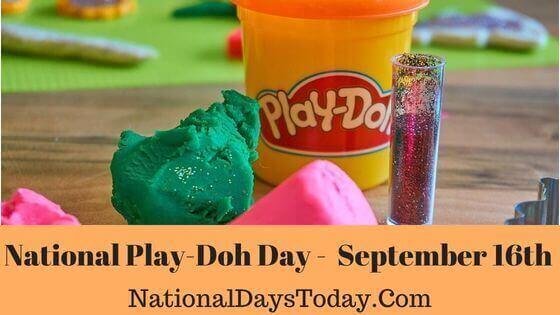National Play-Doh Day
National Play-Doh Day:
National Play-Doh Day is celebrated on September 16th to celebrate children’s modeling clay. Before it made its way onto the shelf for crafting, Play-Doh had more practical applications.
| Year | Date | Day | Where |
| 2023 | 16th September | Saturday | United States |
| 2023 | 16th September | Monday | United States |
| 2025 | 16th September | Tuesday | United States |
Twitter Hashtags:
#NationalPlay-dohDay
#Play-dohDay
Related: Other National Days Celebrated on September 16th:
National Cinnamon Raisin Bread Day
Why National Play-Doh Day?
It’s a quick mood boost.
The mere mention of Play-Doh can bring back countless childhood memories of creating clay creations at home and in school with our classmates.
It’s a reminder that rejecting is a form of redirection
The decline in sales of wallpaper cleaners was a saga, but it opened the door for something more significant than the product was intended to be used for.
It brings out our inner child.
The National Day of Play-Doh is an occasion of celebration, and a day for all people, regardless of age, to come to one another and let the clay artists go free.
How to observe National Play-Doh Day?
Celebration of National Play-Doh day is easy. Get a play-doh box and unleash your talent and creativity using various shades. It is a good idea to encourage your kids to play with the clay because it can help them learn numerous things faster. Play-Doh can help strengthen their muscles as you stretch out and squeeze clay.
Share and post your Play-Doh Day celebrations and your creative ideas with the hashtag #NationalPlayDohDay on social media.
Interesting facts National Play-Doh Day:
It was first sold as a wallpaper cleaner
When children were still playing with Play-Doh, the parents of their children used it to clean dirt and soot off their walls simply by rolling the play-doh across the floor.
It was an infancy company without an advertising budget. The inventor Joe McVicker went on a visit with Bob Keeshan, a.k.a. Captain Kangaroo. Even though the company couldn’t pay for the entire show, McVicker offered them two percent of Play-Doh sales to show the product at least once weekly. Keeshan was a fan of the product and decided to feature it three times per week.
Since 1956, over 3.0 billion containers of Play-Doh have been sold. This is enough to get to the Moon and return thrice.
The canning industry sells more than 100 million bottles each year.
7 Million Fun Factory of playsets have been sold out since 1999.
It used to come in just 1 color
When it was a product for the household, Play-Doh came in just one color called off-white. It was first introduced to the shelves as a toy during the 1950s; blue, red and yellow were added. Nowadays, Play-Doh comes in nearly every rainbow color–more than 50 altogether. But an online survey of consumers showed that the top three color choices include Rose Red, Purple Paradise, Garden Green, and Blue Lagoon.
You can smell like play- doh
Do you want the smell of Play-Doh? You can! In celebration of the compound’s fiftieth birthday, Demeter Fragrance Library worked with Hasbro to create the Play-Doh scent, designed to appeal to “highly-creative people, who seek a whimsical scent reminiscent of their childhood.”
History National Play-Doh Day:
The origin of the day is not found but the Play-doh has a prolonged history!
Origin-
The non-toxic, non-staining, and reusable modeling compound that became known as “Play-Doh” was a pliable putty-like material invented by Noah McVicker of Cincinnati-based soap manufacturer Kutol Products. It was created on the request by Kroger Grocery, which wanted an item that could be used to clean coal residue off the wallpaper.
After World War II, with the shift from coal-based house heating systems to the use of natural gas, the subsequent reduction in internal soot, and the advent of washable, vinyl-based wallpapers, the demand for wallpaper cleaning putty slowed down significantly. McVicker’s nephew, Joe McVicker, joined Kutol to save Kutol from bankruptcy.
Joe McVicker was the brother-in-law of the teacher at nursery school Kay Zufall, who had read about art projects using the cleaning glue for wallpaper. Students loved the activity, and she convinced Noah McVicker (who also sold the putty) and Joe McVicker to manufacture it to be a plaything for children. Zufall, along with her husband, invented the name Play-Doh. Joe McVicker and his uncle Noah had wished to name the product “Rainbow Modeling Compound.”
Launch
Joe McVicker took Play-Doh to an educational conference for producers of school supplies. Woodward & Lothrop, a department store in Washington, DC, began selling the product. In 1956 the McVickers created The Rainbow Crafts Company to make and market Play-Doh. In 1956, the company introduced a three-pack of 7-ounce cans was added to the line.
Following the demonstrations in stores, Macy’s located in New York and Marshall Field’s of Chicago established retail accounts. In 1957 the scientist Dr. Tien Liu reduced Play-Doh’s salt content and Play-Doh advertisements were shown in Captain Kangaroo, Ding Dong School, as well as Romper Room. In 1958, sales of Play-Doh exceeded $3 million.
Subsequent developments
From 1964 onwards, Play-Doh became available for export in Britain, France, and Italy. In the year of 1965, Rainbow Crafts issued a patent for Play-Doh. In 1965, General Mills bought Rainbow Crafts for 3 million dollar. In 1971, Rainbow Crafts and Kenner Products joined forces, and 1987 in 1987, the Tonka Corporation purchased both.
Through the 80s, the company’s cardboard container (with a rust-prone bottom made of metal) was replaced by an affordable plastic container. The year 1991 marked the first time Hasbro was acquired by the owners of Play-Doh and continues to produce the product to this day. In 1996 Gold and silver were added to the Play-Doh palette to commemorate its 40th anniversary.


